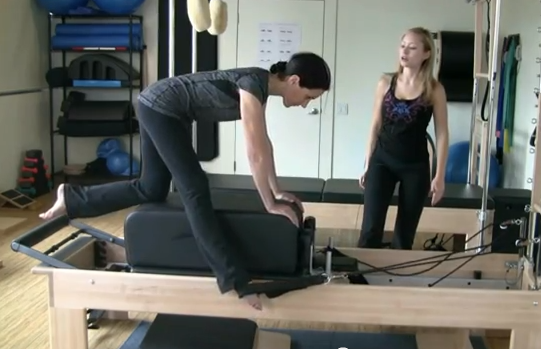“For every complex problem there is an answer that is clear, simple and wrong.” – H. L. Mencken
This week I thought I’d take up a subject that is close to my heart, one that I’ve been looking into for some time now in both myself and my clients. And that subject is working symmetrically. Through my experience most of us have dominant areas that invariably take over the less dominant areas of the body whilst performing exercises. With the dominant use of one part of the body it inevitably pulls us out of alignment causing the exercise to be performed, more or less, asymmetrically.
In the past I would have instructed myself or my clients to ‘straighten up’ or ‘even out’ in an attempt to fix the imbalance by directly correcting the asymmetric performance. In this situation the client is usually able to respond to my verbal and or manual correction and from an exterior point of view things look to be going better. In taking this direct route I have come to conclude that it’s perhaps not the most valuable approach long term. Personally, my right side is generally dominant and has more strength and coordination than my left side. Throughout my life I have received and still do receive corrections to ‘straighten out’ or to try to engage my less dominant side more. As the younger Brett, I would do this but over time the dominance persisted and even increased. So I found this supposedly simple solution has had little positive effect for me.
Therefore in applying the H L Mencken’s quote, the simple answer to the complex issue of working symmetrically may actually be wrong. And yet despite this I want my clients to work to their full potential and that undoubtedly occurs with good alignment.
I would like to take the opportunity here to restate the purpose of this newsletter, wherein we share ideas and challenge each other’s knowledge and understanding of our education and experience. I don’t intend to suggest I have THE answer; I want this to be a discussion where you feel your input is welcome and valid.
Having reiterated that, what is one to do about this issue of working symmetrically? I think the first step is to bring this uneven use to the awareness of the client so that they can actively participate in changing it. More recently I have begun to take a more indirect approach in helping my clients to become more sensitive to what they are doing in and out of the studio, and in time, work more symmetrically.
For example, I have a client Greta, who has a dominant side where the right does all the work and the left is weak and lacks control. During ‘Feet In Straps-One Leg Pull’ on the Reformer Greta worked like a champ with her right knee on the box, supporting the action of the left side. But on the other side Greta had a hard time even staying on. Her left side was unable to support the working of her right.
‘Feet In Straps-One Leg Pull’ courtesy of Amanda Majewski at Simply Pilates, Austin Texas.
Amanda’s views do not necessarily coincide with those expressed in this article. This image simply illustrates the exercise I refer to, not to show any dominance. The lady doing the exercise looks great!
After seeing this, the first thing I did was to point out the dominance of her right side- an easy task since the dominance was so acute. We then went back to a more basic exercise, Footwork on the Reformer. Here the dominance wasn’t as easy to detect with the majority of the body supported by the carriage and yet it was still present. As in ‘Feet In Straps-One Leg Pull’ I helped Greta to bring consciousness to her stronger right side, encouraging her not to correct it but to do the exercise in a way that felt true to her body. It may seem counter intuitive to allow a problem to persist but in doing this I believe it can build an awareness and understanding of the patterns which are causing the dominant side to exist in the first place.
Together, Greta and I observed that her right side shortened and curled slightly whilst doing Footwork. This led me to ask if she noticed favoring her right side in her everyday life, but Greta wasn’t sure that she did. But then I got lucky. When adjusting the Reformer for the next exercise, Greta stood to the side waiting patiently, and how was she standing? With all her weight on her right foot, with both hands on her right hip and curling her torso and head over to the right side- the identical position (or at least almost) that she adopted in Footwork. BINGO! I had caught the culprit in action!
But all excitement aside, I asked Greta not to change her stance. Indeed this request was easier said than done, as I think we’ve all been taught to be on high alert to correct ourselves at the slightest suggestion. But, she was able to do it. Whilst maintaining the position, we looked at the habitual patterns she was using, that up until that moment had gone unnoticed in her everyday life. I asked her just to ‘be’ in this position, even getting her to exaggerate it so that she could take a mental note of how it felt. In order to come out of this stance and into a more neutral alignment, I instructed Greta to start connecting the deep abdominals for support whilst releasing the neck and shoulders, transferring more weight over to the left foot and letting her arms come by her side. This whole movement sequence was purposefully repeated approximately 5 times, continuously taking note of the changes that occurred, however subtle.
I encouraged Greta to look for moments in her everyday life where she employed this holding pattern. I advised her to apply the same approach we practiced by considering the body as a whole. In exploring issues specific to the individual, it allows both the client and I, as an instructor, to find a deeper knowledge of the body, working together towards a more balanced and sustainable alignment. I found Greta was engaged and interested to learn more about her body and to be given the tools to help herself.
But we all know Rome was not built in a day, and needless to say this exercise in awareness did not rectify the problem in that moment. However it was the promising start down a path I consider to be more valuable and correct. This is also the first of many articles to address the issue of dominance in alignment, though this one’s getting pretty long now, wouldn’t you say?
Have a great teaching week!!


